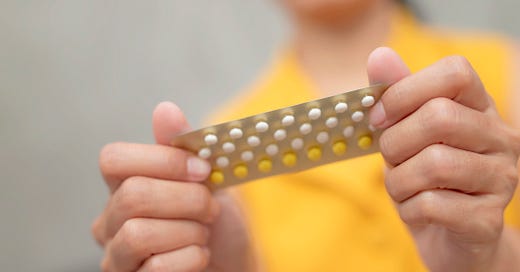Can you do an article on birth control for amenorrhea and PCOS?
@gimpstagram_
Short Take…
The estrogen-containing birth control pill is recommended for women who have no periods (amenorrhea) or infrequent periods and low levels of estrogen to protect the bones against osteoporosis (and provide contraception if needed). For women with few or intermittent periods due polycystic ovarian syndrome (PCOS), the pill can provide cycle control, reverse some of the hormonal changes associated with PCOS, protect the lining of the uterus from cancer, and provide contraception if needed.
Tell Me More…
There is a lot of misperception and, quite frankly, disinformation about how the birth control pill with estrogen (also called combined oral contraceptives or COCs) are used when periods are infrequent or have stopped. For our purposes here we will confine the discussion to women ages 40 and younger with no periods (amenorrhea) or infrequent periods (oligomenorrhea) who most definitely know they are not pregnant.
Irregular or infrequent menstrual periods are the result of a disturbance with ovulation, either disordered ovulation (hormones are made, but the levels are abnormal), or lack of ovulation (no hormones are made). Typically, no investigation is needed until there have been three skipped periods as the menstrual cycle is a pretty sensitive barometer and a period of stress or a minor illness can affect the coordinated signaling responsible for ovulation. There is one caveat—don’t wait three months for a pregnancy test.
Aside from pregnancy, there are three main reasons for lengthy delays between periods or no periods that are related to the ovary and are potentially treated with estrogen containing birth control pills.
Before we dive in, let’s briefly run through the menstrual cycle. Complex signaling from the brain triggers follicles (eggs and their surrounding tissue) to start developing. Several follicles are recruited and they produce increasing amounts of estrogen. Typically one follicle becomes dominant and the others disappear. The estrogen produced by the larger group of follicles and then by the dominant follicle builds the lining of the uterus. With ovulation, the hormone progesterone is released stabilizing the lining of the uterus and preparing it for a potential pregnancy (progesterone is progestational). If there is no pregnancy, the progesterone is withdrawn and the lining is destabilized and comes out as menstrual blood.
The main mechanisms that interrupt this process are as follows:
Primary ovarian insufficiency or POI: This is often thought of as premature menopause, but some people may ovulate infrequently so premature menopause is a bad analogy. Here the follicles are not responding to the wake-up signal from the brain. With POI there is either no estrogen produced by the ovaries as the follicles are no longer capable of ovulation, or estrogen is produced very infrequently with the occasional ovulation. The lack of bleeding or infrequent bleeding signifies a lack of estrogen.
Interruption of brain-ovary signaling: When this happens the follicles aren’t receiving a wake-up signal each month, so there is no ovulation, or they get an occasional signal, so there is occasional ovulation. One cause is hypothalamic amenorrhea, a condition where the hormone signaling from the brain is temporarily suppressed—there are many potential causes including low body weight, eating disorders, exercise, stress, or chronic illness. Medical conditions such as a low thyroid or an elevated level of the hormone prolactin can also affect the signaling. This lack of bleeding or infrequent bleeding signifies a lack of estrogen.
Disordered ovulation: One common cause is polycystic ovarian syndrome or PCOS. The follicles receive disordered wake-up signals. Unlike the interruption of brain-ovary signaling described above, the follicles are producing hormones but ovulation often doesn’t happen. The net result (the hormone interactions here are complex) is (typically) normal levels of estrogen and elevated levels of testosterone and often elevated levels of insulin. Another cause of disordered ovulation is obesity, which is associated with increased levels of testosterone, estrogen, insulin, and inflammation that can interrupt the signaling needed for the follicles to develop and for ovulation. When ovulation doesn’t occur, the lining of the uterus gets thicker and thicker from the estrogen as there is insufficient progesterone to hold it in check. Without the progesterone withdrawal, there is no period. The thick lining of the uterus can break off intermittently, resulting in irregular bleeding. Menstrual periods, when they occur, are often heavy. The lack of bleeding or infrequent bleeding signifies insufficient progesterone.
This is an excerpt from today’s subscriber-only Ask Dr. Jen. To read the entire article and get full access to the archives, you can subscribe for $5 a month or $50 a year.




